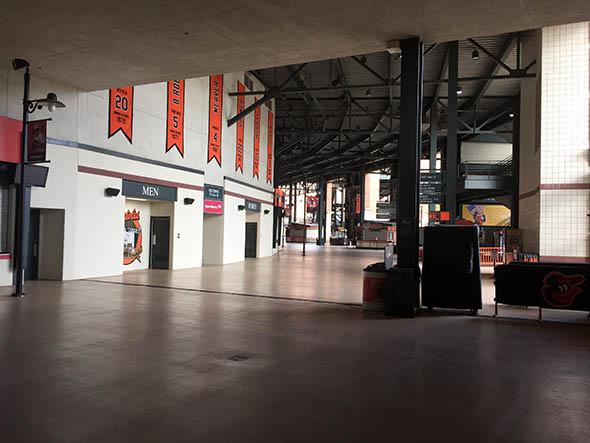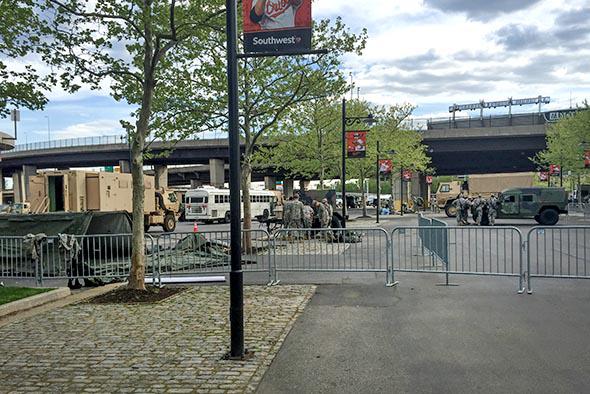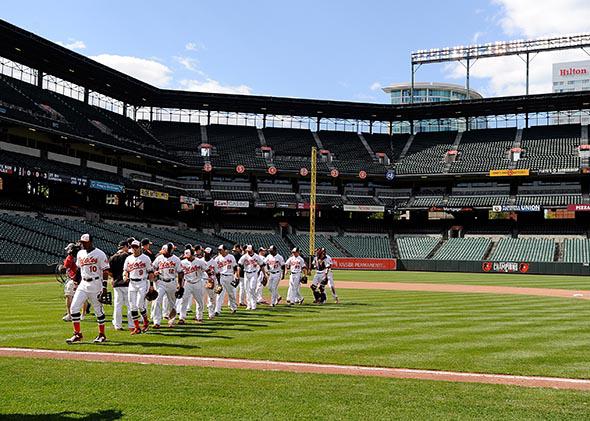As Baltimore again sat on a razor’s edge on Wednesday, the Orioles played baseball. What else could they do? Their city, convulsing in riots over the brutal death of a young black man in police custody, was deemed too dangerous for baseball on Monday and Tuesday. By Wednesday, the uproar had abated enough to hold a game—but in an unprecedented move, the Orioles and Major League Baseball elected for the team to take on the Chicago White Sox in an empty ballpark, refusing to give paying fans admission. Although such games aren’t uncommon in soccer, Wednesday’s closed-door contest was entirely unprecedented.
I wangled a press pass to this somewhat historic occasion, in part to cover the weirdness of a fan-free game, in part because I’m a moderately fanatical baseball devotee and was eager to find out what baseball was like without anyone in the stands. When I walked up to the stadium a half-hour before the game began, a few diehard fans were clustering around the gates, struggling to follow along from afar. It was, several told me, too perfect a day for baseball to miss the contest. (The game-time weather was 73 degrees with a slight breeze.) Nobody seemed particularly bitter about the cause of the locked gates, or concerned about the riots that rocked their city. They were there to watch a baseball game.
Throughout the afternoon, about two dozen fans cheered on every Orioles success, providing the only audible reaction as the team clobbered the White Sox from the outset. (If there were any White Sox fans at the gate, they didn’t make much noise.) After two days of canceled games, the Orioles stormed the field with palpable vigor, gaining a quick 4-0 lead in the first inning when Chris Davis slammed a homer over the right-field wall. The ball landed quietly onto Eutaw Street—a spot where kids have been chasing dingers from the game’s most powerful hitters for more than two decades—which is where it remained unclaimed for hours on the ground by the men’s bathroom.
After that early thrill, the game settled into a familiar rhythm, albeit at a ridiculously fast pace. (For a reason I can’t quite suss out, the absence of fans makes the innings fly by; the game lasted just more than two hours.) The Sox regained a little momentum, scoring twice in the top of the fifth to cut the deficit to 7-2. It was both odd and affecting that I could hear the Sox’s dugout encouraging their teammates on the field, as Adam LaRoche rounded home plate, shouting “here we go!” as though they could bend the direction of the game through the force of encouraging bromides.
But that victory was short-lived: Manny Machado homered in the bottom of the fifth to give his team back a six-run lead. The Orioles closed out the 8-2 win, their fans screaming and hollering with excitement at the gates while the players dutifully lined up to shake hands. They then filed off the field somewhat somberly, a hush falling over the stadium as employees hustled out to pull a drag across the diamond.
Despite the best efforts of the park’s DJ—who played a constant stream of upbeat post-punk hits—the mood of the entire day was like that: Palpably subdued, with a burst of melancholy following every great play made in near-total silence. Maybe it was the thousands and thousands of empty seats, in which players stranded dozens of foul balls. Maybe it was the little wrist-flick several players made when they got a hold of dead balls, primed to normally toss them into the stands for fans to clamor over. Maybe it was the fact that, toward the end of the game, an announcer deadpanned to the press room: “Attention media: For record-keeping purposes, today’s official paid attendance is zero.”
Whatever made the day so hushed and surreal, one thing was clear from the start: This is a terrible way to experience baseball. Yes, you could hear every thwack and crack and whoosh and grunt; yes, you could hear the umpire snarl his call, and hear the dugout grumble when he called a ball a strike; and yes, you could even hear the players spitting. But the essence of the game—the joy of a hit, the agony of an error, even the exasperation of an overlong seventh-inning stretch—was drained out of the day’s proceedings. (The lifeless response to the O’s traditionally raucous seventh-inning stretch playing of John Denver’s “Thank God I’m a Country Boy” felt especially sad.) Instead, a bunch of writers sat in a box and watched highly paid men run around a field, while the true fans stood on their tiptoes to glimpse the game through metal bars. There was no mascot, no dance cam, no booming shouts of “charge!” It is, to my mind, always at least a little fun to watch baseball. But Wednesday’s fun came with a mightily depressing hangover.
If the Orioles were attempting to make a statement with Wednesday’s empty game, then, they succeeded. Americans have a habit of ignoring inequality until it claws them in the face. One goal of the Baltimore protests was to force the country, or at least the police force, to recognize the horrors the city has inflicted on impoverished, mostly black communities. Much of the country dismissed the rioters as “thugs,” while others simply ignored them. It’s easy to write off people who riot in a bad part of town. It’s not so easy to write them off when their protests lead to the eerie, unprecedented spectacle of a televised professional baseball game played to an official audience of zero.

Photo by Mark Joseph Stern
Perhaps that inescapable background, not the novelty of a silent game, is what made Wednesday’s contest so uncomfortable. While the rest of the city protested police overreach—and mourned over those who have died for no reason—some reporters and athletes gathered in an empty ballpark downtown to watch America’s pastime on mute. While we rose for a prerecorded Star-Spangled Banner, the National Guard set up shop at a makeshift camp just outside the park.

The National Guard outside an empty Oriole Park at Camden Yards on April 29, 2015 in Baltimore, Maryland.
Photo by Mark Joseph Stern
While we filed out after the anticlimactic final play, the city hunkered down for another anxious night. Thanks to decades of police brutality and discrimination, the most quintessentially American sport had to be played in an empty stadium. And you could watch the whole thing on TV.
Read all of Slate’s coverage of Freddie Gray’s death and the unrest in Baltimore.
